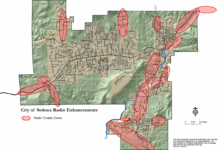While the three lightning-caused wildfires burning in northern Arizona are outside the Verde Valley, the valley has also been affected by wildfire smoke from both the north and south during the last week.
The Coconino National Forest is currently managing three fires located in each of its three districts, which are instrumental in aiding hazardous forest fuels reduction, wildlife habitat improvement and watershed protection.
While National Forest fire managers have been working to confine the Miller Fire to as small a footprint as possible in a branch of Secret Canyon north of Sedona, smoke from that blaze really isn’t affecting us here, as odd as it may seem. That blaze remains about 30 acres in size and is more or less contained by fire crews and the rough terrain. The 474-acre Wilbur Fire is burning just south of West Clear Creek Wilderness. Smoke from that fire has also been relatively minimal except for those people passing through the area to the east of Camp Verde while en route to Pine, Strawberry and Payson.
The primary source of our morning and late evening smoke is the 2,675-acre Volunteer Fire burning at the far northern end of Sycamore Canyon, immediately south of the southwestern corner of Camp Navajo, the 43-square-mile Arizona National Guard munitions depot and training ground west of Flagstaff.
In the daytime, northerly summer winds push the smoke north over Bellemont and the western reaches of Flagstaff, but at night when the air cools, that smoke settles into Sycamore Canyon and onto the Coconino Plateau, spilling into the western Verde Valley and the Seven Canyons area before reaching Clarkdale and Sedona, respectively.
Before modern firefighting policies dedicated to extinguishing all fires, all the time, at the moment they started, emerged, wildfires were vital to ongoing forest health in what is now the western United States. Lightning-caused blazes would burn out old growth and make way for new trees and plants. Some pine trees have cones that only open after being subjected to the extreme heat of a wildfire — they evolved to rebuild their species after a fire passed through and could lie dormant for decades waiting for that rejuvenating wildfire.
Decades of human wildfire management have now upset that balance, which botanists and arborists are only recently attempting to restore.
“The Coconino National Forest is working with partners to restore healthy, resilient landscapes, and fire is a natural part of that process,” the U.S. Forest Service states. “Healthy ecosystems are less vulnerable to extreme wildfires that can devastate watersheds, destroy wildlife habitat and risk lives … The Coconino National Forest will continue to suppress wildfires safely when needed and will continue to manage naturally-caused wildfires to improve forest health when conditions and timing are suitable.”
Due to wildfires in Ontario, Canada, major U.S. cities on the East Coast are now experiencing the kind of wildfire effects we here in the west have dealt with for decades. Maybe this mutual suffering in the Beltway from New York City to Washington D.C., will lead lawmakers to provide better funds for the U.S. Forest Service so that we … nah, that’s not going to happen. Who am I kidding?
Most healthy adults and children will recover quickly from smoke exposure and will not suffer long-term health consequences. However, exposure to fine particles can affect healthy people, causing respiratory symptoms and reductions in lung function. Particle pollution may also affect the body’s ability remove foreign materials from the lungs, such as pollen and bacteria, leading to illness after a wildfire has abated.
Certain sensitive people may experience more severe acute and chronic symptoms. Those most at risk are:
- People who have preexisting heart diseases, chest pains, lung diseases or asthma.
- Older adults who have weaker immune systems, and especially seniors at risk for heart and lung diseases.
- Very young children. Children’s airways are still developing and they breathe more air per pound of body weight than adults do. Also, children often spend more time outdoors engaged in activity and play. Fine particles can be inhaled deeply into the lungs. Exposure to the smallest particles can affect the lungs and heart.
Fine particles are respiratory irritants and exposure to high concentrations can cause persistent cough, phlegm, wheezing and difficulty breathing.
If you have a central air conditioning system in your home, set it to recirculate or close the outdoor air intakes to avoid drawing in smoky outdoor air.
Christopher Fox Graham
Managing Editor
